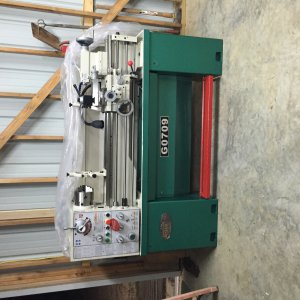-
Welcome back Guest! Did you know you can mentor other members here at H-M? If not, please check out our Relaunch of Hobby Machinist Mentoring Program!
You are using an out of date browser. It may not display this or other websites correctly.
You should upgrade or use an alternative browser.
You should upgrade or use an alternative browser.
Grizzly G0709 On The Way!
- Thread starter OLEJOE
- Start date
- Joined
- Nov 23, 2014
- Messages
- 2,606
The lathe weighs 1300 lbs., may want to consider an engine hoist rental at least. While you have it in the air you may consider installing leveling feet. I made mine from some 1/2" thick aluminum plate and 1/2" bolts/nuts.
I'm really happy with my lathe. To me the universal gear box was the selling point; turn one knob to switch from English to Metric threading and back.
Bruce
I'm really happy with my lathe. To me the universal gear box was the selling point; turn one knob to switch from English to Metric threading and back.
Bruce
- Joined
- Aug 12, 2013
- Messages
- 858
A few things if you do that:Good question. I have exposed joists in my shop and I thought I might be able to lift it up off of it.
1. eyelets. Be careful what you use (the bent not welded ones are only good for about 100#).
2. Think about lifting from two different joist to spread the load. This requires two chain falls, but that makes the lathe much easier to handle instead of balancing on a single pick point. And chainfalls are cheaper then busted equipment.
3. I lifted mine with two 3/4" or 1" steel rod through the lifting holes. Don't use pipe. Think about how you are going to keep the chain from slipping off the bars when the load starts to shift (this thing is massively top heavy).
4. Do a static test first. Lift it 1/2" then walk away for about 30 minutes and see if anything changes.
What is the dimension of your joists and what is the length of them? If they are manufactured trusses (i.e. 2x4) then I would definitely not do it. I lifted off a 2x10" when putting together my gantry crane (which meant I was probably picking up about 600#).
- Joined
- Nov 23, 2014
- Messages
- 2,606
Looks great! Now all you have to do is run power, break it in, come up with a list of projects, start drooling at miscellaneous tooling, etc. etc. etc.
There's a thread in this forum on my set up experiences. My biggest annoyance was the position of the QCTP locking lever - setting over top your work when it's tight. I (surface) ground the plates on the piston style pressure plates to change the handle position. I also pulled the cross slide micrometer dial and went to a locking screw. I just didn't like the clutch system they have; always seemed to let the handle rotate a few 0.001's as I rotated the micrometer dial.
Bruce
There's a thread in this forum on my set up experiences. My biggest annoyance was the position of the QCTP locking lever - setting over top your work when it's tight. I (surface) ground the plates on the piston style pressure plates to change the handle position. I also pulled the cross slide micrometer dial and went to a locking screw. I just didn't like the clutch system they have; always seemed to let the handle rotate a few 0.001's as I rotated the micrometer dial.
Bruce
- Joined
- Nov 27, 2015
- Messages
- 603
Couldn't you just rotate the nut on the bottom for the QCTP?Looks great! Now all you have to do is run power, break it in, come up with a list of projects, start drooling at miscellaneous tooling, etc. etc. etc.
There's a thread in this forum on my set up experiences. My biggest annoyance was the position of the QCTP locking lever - setting over top your work when it's tight. I (surface) ground the plates on the piston style pressure plates to change the handle position...
Bruce
 Steve Shannon
Steve Shannon 
- Joined
- Nov 23, 2014
- Messages
- 2,606
Hi Steve,Couldn't you just rotate the nut on the bottom for the QCTP?
Steve Shannon

My QCTP doesn't have a nut accessible on the bottom (unfortunately). That would have worked great it there was one. I thought about grinding the bottom of the post also, but ended up grinding the two plates instead. There's a youtube video by JayTee going over his G0709, he talks about having the same problem. Still really happy with the lathe.
Bruce
- Joined
- Aug 12, 2013
- Messages
- 858
Yeah, that sure was annoying. My solution was just to buy an Aloris. Not a fan of the cheap piston style tool posts.My biggest annoyance was the position of the QCTP locking lever - setting over top your work when it's tight. I (surface) ground the plates on the piston style pressure plates to change the handle position...


